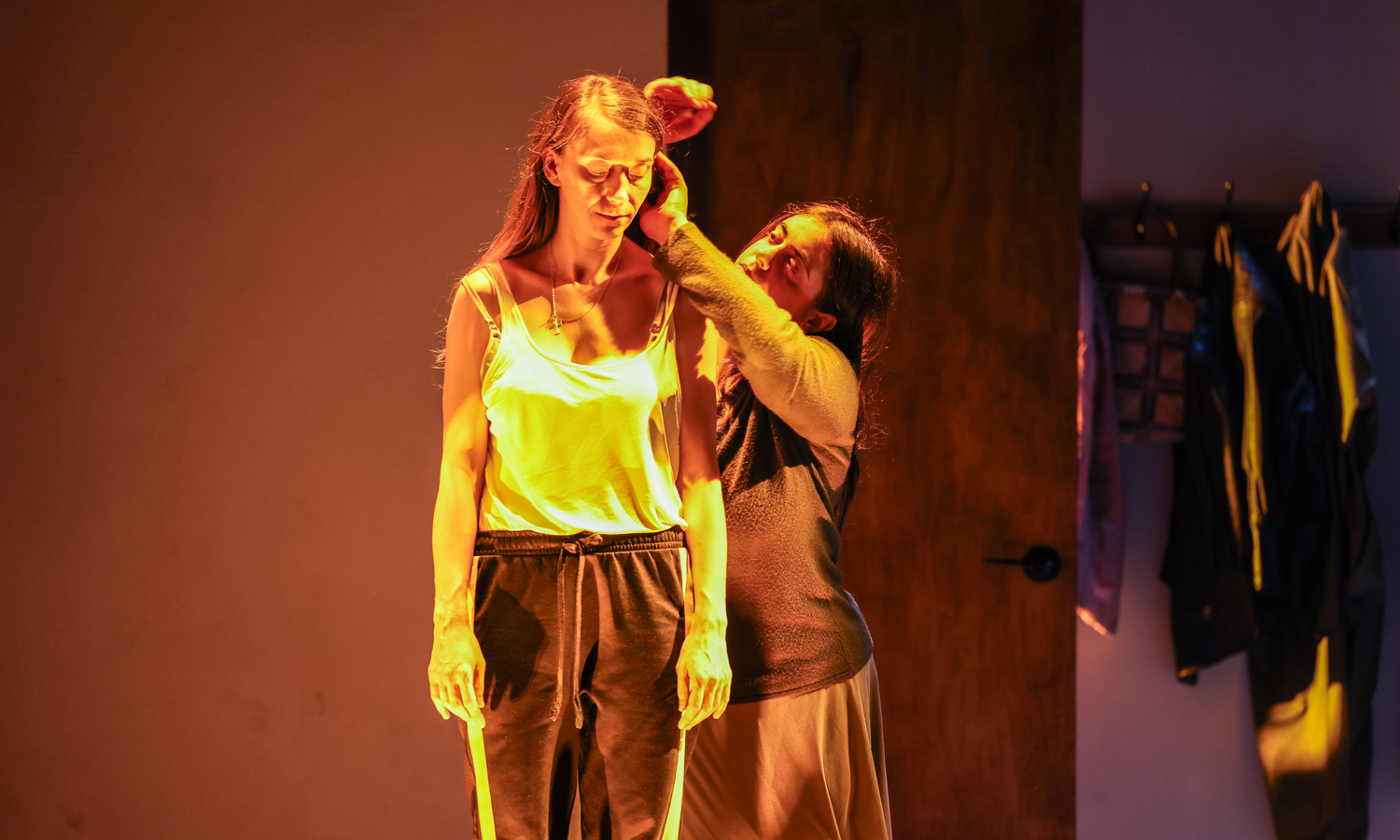“I feel like mourning has a silent, almost suffocating quality,” Mario Banushi writes in his program notes. “This is why it is a performance without words.”
Conceived and directed by Banushi, Goodbye Lindita may be wordless but it has plenty to say.
Inspired, or perhaps provoked, by the death of his stepmother (followed three days later by his father’s death), he has fashioned a work of impressive originality. With only his second stage production as a director, Banushi, Albanian-born and now Athens-based, is surely, at aged 26, already an exceptional theatre-maker .
As the curtain rises on the first tableau we are seeing a theatrical sensibility of extraordinary assurance. The set, designed by Sotiris Melanos, is a single room extending across the entire stage. It is mundane and the people in it are listless and restless. Two are mindlessly watching a vacuously perky TV program but it seems to soothe, or at least distract them. Another is lying on a large quilted bed completely covered and still. Later, a woman starts folding clothes and vacuuming. They move slowly, and in the quiet we hear their feet scuff.
The room is dim but, by the window, rays of sunlight diffuse through the slatted blinds and curtains. Another light captures a row of coats on hooks as if it were a vignette in a Vermeer painting, or a more mellow Hopper. Designed by Tasos Palaioroutas, the lighting is as surprising as it is exquisite.
The people are both agitated and immobilised by grief. There is a boredom mingled with the sadness, frustration with this hiatus before things burst into action. Which they do when what looks like an ordinary dresser is wheeled into centre stage and unfolded like a wooden puzzle to reveal the naked body of the deceased Lindita.
The women begin to wail and writhe and touch her skin. They sprinkle earth on her and rub her. Then they carry her to where the bed has been dismantled and morphed into a bath where, in lighting reminiscent of Titian or Tintoretto, they take turns at bathing her hair and body.

Alexandra Hasani gives a memorable performance as Lindita. Photo: Russell Millard
She then stands naked and silently in front of us for what seems the longest time. Banushi has a canny instinct for silence and stillness when so few directors would dare risk such longueurs.
Banushi creates a familiar tableau of mourners preparing the loved one for the funeral. They stand Lindita (memorably played by Alexandra Hasani) upright and begin to clothe her in an ivory satin dress, with a pinkish sash and layers of traditional necklaces and a face mask. It is an archaic peasant ceremony but there is nothing anthropological about it. After Lindita is laid to rest, in a director’s cameo, Banushi climbs on stage and lays armloads of flowers around her bed. It is an actual moment of homage to his stepmother, and poignant for being so.
Goodbye Lindita is interspersed with music, images and themes which disrupt and reframe much of what we think we are seeing. Emmanouel Rovithis’ inventive, and often astonishing, score and sound contrasts the stage silences with a bewildering range of trumpets, percussion (including the graunching and tormenting of found objects), sublime choral excerpts, folk music, and ominous vocals, synth washes and other electronica.
These sounds intersect with, but also undercut or contradict, what we are seeing. But these tensions relate to Banushi’s preoccupation with what lies between this world and the possible next. That line which is crossed by the dead but also beckons for those left behind.
The play is full of weirdness and portents. An African woman with a guitar sings outside the window early in the play and returns later as a Black Madonna. A traditional iconic painting of Mary is removed from the wall to reveal a portal through which one can climb. In a Dali-esque moment, a hand reaches out of the wall and caresses a weeping woman. Late in the play several of the women engage in frenzied naked Dionysian gyrations and contortions.

Get InReview in your inbox – free each Saturday. Local arts and culture – covered.
Thanks for signing up to the InReview newsletter.
Goodbye, Lindita is a reminder of the inventive possibilities of theatre. We can only hope that, when Banushi completes the final work of his trilogy, it will be performed here also. In the meantime we have already seen a 2024 Festival highlight.
Goodbye, Lindita is playing at the Dunstan Playhouse until March 3.
Read more 2024 Adelaide Festival coverage here.
Support local arts journalism
Your support will help us continue the important work of InReview in publishing free professional journalism that celebrates, interrogates and amplifies arts and culture in South Australia.
Donate Here




